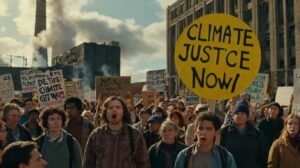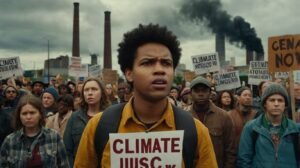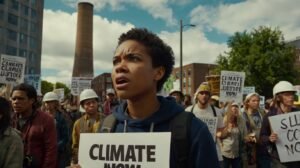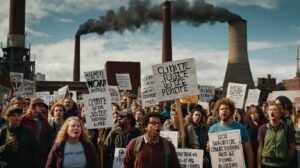
Introduction
As we navigate through 2025, the harsh realities of climate change have become increasingly evident. Global temperatures continue to rise, extreme weather events are becoming more frequent, and communities worldwide are experiencing the devastating impact of environmental degradation. In response, a wave of protests has surged across the globe, uniting individuals from diverse backgrounds under a common cause: the urgent need for action against climate change. This article explores the motivations behind these protests, the influential voices leading the charge, and the broader implications for society. For more insights on social issues, visit zaroraterishta.com.

Section 1: The Climate Crisis in 2025
2025 has seen unprecedented climate challenges that have shaped public perception and mobilized communities. According to the latest reports from climate scientists and meteorologists, global temperatures have increased by 1.5 degrees Celsius since pre-industrial levels, leading to catastrophic changes in weather patterns. Severe droughts, hurricanes, and wildfires have become common headlines, with millions displaced from their homes and entire ecosystems disrupted.
Impact on Agriculture and Food Security
Agriculture, a cornerstone of many economies, has been significantly affected. In countries like Bangladesh, rising sea levels have submerged entire villages, forcing families to abandon their ancestral lands. Farmers are struggling to adapt to changing weather patterns, leading to decreased crop yields and food shortages. The Food and Agriculture Organization (FAO) has warned that climate change could push an additional 100 million people into hunger by 2030.
Wildfires in the United States rage through California, destroying homes and ecosystems. The smoke from these fires has led to air quality crises, affecting the health of millions. The devastating impact on agriculture and food security has heightened public awareness and urgency, driving individuals to join protests demanding immediate climate action.
Personal Stories and Local Impact
These events are not isolated; they reflect a global crisis transcending borders and demanding collective action. Personal stories are at the heart of this crisis. Take, for instance, the story of Aisha, a farmer in Kenya, whose crops have failed due to prolonged droughts. Aisha is not alone; she represents countless others who are facing food insecurity and loss of livelihood due to the changing climate. Her determination to advocate for sustainable practices highlights the human toll of climate change and the urgency of the protests igniting around the world.
Another poignant example is the plight of families in the Pacific Islands, where entire communities are at risk of being submerged by rising ocean levels. The emotional toll on these families, who are losing their homes and cultural heritage, fuels a sense of urgency among activists. Their stories resonate globally, reminding us that climate change is not just an environmental issue; it is a human rights issue.
Health Impacts
The health impacts of climate change are also profound. Increased temperatures contribute to heat-related illnesses and deaths, particularly among vulnerable populations such as the elderly and those with pre-existing health conditions. Furthermore, climate change exacerbates air pollution, leading to respiratory issues and other health complications.
Extreme weather events, such as hurricanes and floods, result in injuries, loss of life, and mental health crises. The trauma experienced by individuals and communities following such disasters can have long-lasting effects, further amplifying the need for urgent climate action. The health consequences of climate change are yet another driving force behind the protests, as individuals demand that governments prioritize public health in their climate policies.

Section 2: The Rise of Global Protests
The global protests of 2025 did not emerge overnight; they are the result of a long history of environmental activism. Movements such as the 2019 climate strikes, inspired by young activists like Greta Thunberg, laid the groundwork for what we see today. These early efforts galvanized a generation, emphasizing the interconnectedness of social justice and environmental stewardship.
Major Protests and Key Events
In 2025, cities around the world witnessed massive demonstrations. From the streets of Paris to the squares of Tokyo, activists rallied to demand action from their governments. One notable event was the “Global Climate March,” where over a million people marched in solidarity, calling for immediate action to reduce carbon emissions and promote renewable energy.
In India, protests erupted in response to devastating floods that displaced thousands. Activists organized rallies demanding better infrastructure and climate-resilient policies. The images of young people holding banners and chanting slogans became symbols of resistance against inaction.
In Africa, youth-led movements gained significant traction, with demonstrations in countries like Nigeria and South Africa demanding climate justice. The African continent, being disproportionately affected by climate change, is witnessing a surge in activism as young leaders emerge to advocate for sustainable solutions that cater to local needs.
Influential Activists and Organizations
Key figures have emerged as leaders in this movement. Activists like Vanessa Nakate from Uganda have brought attention to the experiences of those in the Global South who are disproportionately affected by climate change. Their voices amplify the need for justice and equity in climate policies, reminding us that the fight extends beyond environmental concerns to encompass human rights.
Organizations such as Greenpeace, the World Wildlife Fund (WWF), and local grassroots groups have played pivotal roles in mobilizing communities. They have provided resources, organized events, and promoted awareness campaigns, ensuring that the voices of the marginalized are heard.
The Role of Art and Culture
Art and culture have also played a significant role in the climate protests. Artists, musicians, and filmmakers have utilized their platforms to raise awareness about climate change and inspire action. From powerful documentaries to art installations that depict the realities of climate impact, creative expressions have the power to engage and mobilize people in ways that traditional activism may not.
In many protests, art has served as a unifying force. Murals, chants, and performances create a vibrant atmosphere, fostering a sense of community among participants. This cultural dimension of activism reinforces the message that climate change is not just a scientific issue; it is a deeply human one that requires collective action.
The Role of Technology in Mobilization
Technology has also played a crucial role in organizing and mobilizing protests. The rise of social media platforms has allowed activists to quickly disseminate information, coordinate events, and share personal stories of climate impact. This technological empowerment has enabled grassroots movements to flourish, connecting individuals across borders and fostering a sense of global solidarity.
Moreover, technology facilitates the documentation of protests and the sharing of experiences in real-time. Live streaming and social media updates allow individuals unable to attend protests to engage virtually, broadening the reach and impact of movements. This digital activism complements traditional methods of organizing, creating a multifaceted approach to climate advocacy.

Section 3: Motivations Behind the Protests
The motivations fueling the protests in 2025 are diverse and multifaceted. For many, the protests are driven by a deep concern for future generations. Young people are particularly vocal, inspired by a desire to create a sustainable world for their children. Activism has taken on new dimensions as youth-led movements gain momentum, showcasing creativity and urgency.
Economic Inequality and Climate Justice
Economic inequality also plays a significant role in motivating protests. The climate crisis disproportionately affects low-income communities, leading to a growing recognition that environmental justice is inherently linked to social justice. Activists emphasize that those who contribute the least to carbon emissions often face the harshest consequences, highlighting the need for equitable solutions.
The pandemic exposed and exacerbated these inequalities. As vulnerable communities faced the dual crises of health and climate, their struggles became a rallying point for activists. Demonstrators argue that climate action must prioritize the needs of those most affected by environmental change.
Testimonials from Protesters
Testimonials from protesters reveal a collective sense of urgency. “I’m here because I want my voice to matter,” says Daniel, a university student participating in a protest in New York City. “We cannot wait for leaders to take action; we must demand change now.” These sentiments resonate across various demographics, uniting people in their call for immediate action.
Another protester, Maria, a mother of three, shares her fears for her children’s future. “I want them to grow up in a world where they can breathe clean air and drink safe water. That’s why I’m here,” she states passionately. These personal narratives highlight the emotional depth of the movement, underscoring the stakes involved.
The Role of Education and Awareness
Education also plays a crucial role in motivating individuals to protest. Schools and universities are increasingly incorporating climate education into their curricula, empowering young people with knowledge about the science of climate change and the importance of sustainability. This educational foundation encourages students to engage in activism and advocate for change in their communities.
Many activists emphasize the need for comprehensive climate education at all levels. They argue that by equipping individuals with the necessary tools and understanding, society can build a more informed and engaged citizenry capable of tackling the climate crisis head-on.
The Influence of Global Events
Global events also serve as catalysts for climate activism. Disasters such as hurricanes, wildfires, and floods often prompt immediate responses from communities. The increasing frequency and intensity of such events create a sense of urgency, pushing individuals to take action. For example, the devastating impact of Hurricane Katrina in 2005 galvanized environmental activists and raised awareness about the link between climate change and extreme weather.
Similarly, the COVID-19 pandemic highlighted the vulnerabilities of our interconnected world, emphasizing the need for systemic change. Activists argue that the lessons learned from the pandemic should inform our approach to climate action, advocating for policies that prioritize resilience and sustainability.

Section 4: The Role of Social Media
In the digital age, social media has become a powerful tool for amplifying the messages of climate activists. Platforms like Twitter, Instagram, and TikTok allow for rapid dissemination of information, mobilizing supporters and sharing personal stories of climate impact. The hashtag #ClimateStrike2025 trended globally, serving as a rallying point for activists.
Successful Campaigns and Online Engagement
Successful campaigns have emerged from social media’s reach. For example, the “Fridays for Future” campaign, initiated by Thunberg, has inspired millions of students to participate in climate strikes every Friday. The movement harnesses the power of youth engagement and encourages individuals to take collective action. The impact is tangible, with schools around the world seeing students walk out to demand climate action, often leading to local and even national dialogues on environmental policies.
Activists have also utilized social media to organize events, share educational content, and mobilize supporters. For instance, the “Earth Day Live” event in April 2025 saw thousands of virtual participants across various platforms, showcasing the power of digital activism.
Misinformation and Challenges
However, the rise of misinformation poses challenges for activists. False narratives can undermine credible efforts, leading to confusion and skepticism. To combat this, activists are employing fact-checking initiatives and educational campaigns to ensure that accurate information is disseminated.
Social media platforms are also taking steps to address misinformation, but challenges remain. Activists are urging tech companies to improve transparency and take stronger actions against misleading content related to climate change. The fight against misinformation is ongoing, as activists understand that they must not only advocate for change but also educate the public on the realities of climate science.
The Power of Visual Storytelling
Visual storytelling has emerged as a critical component of climate activism on social media. Photographs, infographics, and videos capture the essence of climate impacts, making the issue more relatable and urgent. Documenting the experiences of individuals and communities affected by climate change fosters empathy and encourages action.
Activists are increasingly using platforms like Instagram and TikTok to share short, impactful videos that communicate their messages in creative ways. These visual narratives resonate with audiences, inspiring them to engage with the cause and share the content within their networks.
The Role of Influencers
Influencers and public figures have also played a significant role in promoting climate activism on social media. With their vast reach and ability to connect with diverse audiences, they can raise awareness and inspire action. Celebrities such as Leonardo DiCaprio, Jane Fonda, and Emma Thompson have used their platforms to advocate for climate action, amplifying the voices of grassroots activists.
Collaborations between activists and influencers can lead to powerful campaigns that engage new demographics and encourage broader participation in climate movements. By leveraging their influence, these public figures can help shift the narrative around climate change and mobilize their followers to take action.
Online Activism and Virtual Protests
The rise of online activism has opened new avenues for engagement, especially during times when physical gatherings are constrained. Virtual protests, webinars, and online forums have become essential tools for activists to connect and share their messages. These digital platforms allow for greater participation, enabling individuals from around the world to unite in solidarity.
For instance, during the COVID-19 pandemic, many activists turned to online platforms to host virtual rallies and discussions. This shift not only maintained momentum but also expanded the reach of climate movements, allowing for diverse perspectives to be shared and heard.

Section 5: Government and Corporate Response
As protests gain momentum, governments are being forced to respond to the demands of their citizens. Some countries have begun to implement more ambitious climate policies, setting targets for carbon neutrality and investing in renewable energy sources. For instance, the European Union has pledged to reduce emissions by 55% by 2030, a significant step toward combating climate change.
Policy Changes and Legislative Action
In the United States, the Biden administration has faced pressure to enact more comprehensive climate legislation. Following the protests, lawmakers introduced several bills aimed at addressing climate change and promoting green energy initiatives. The Green New Deal has gained renewed attention, advocating for a broad approach to tackle economic and environmental challenges simultaneously.
However, political polarization continues to hinder progress. While some lawmakers champion climate action, others oppose regulations, citing economic concerns. This divide underscores the necessity for persistent activism to keep climate issues at the forefront of political discourse.
Corporate Responsibility and Sustainability
Corporate responsibility is also under scrutiny. With increasing pressure from consumers and activists, many companies are adopting sustainable practices. Brands that prioritize environmental stewardship are seeing a shift in consumer loyalty. Companies like Patagonia and Tesla are leading the way by promoting eco-friendly products and practices.
The rise of environmental, social, and governance (ESG) criteria in investment decisions reflects a growing recognition among investors that sustainability is not just a trend but a necessity. As public awareness increases, companies are beginning to realize that their long-term viability is closely tied to their environmental impact.
The Role of International Agreements
International agreements play a crucial role in addressing climate change at a global level. The Paris Agreement, adopted in 2015, marked a significant milestone in the fight against climate change, bringing together nations to commit to limiting global warming. In 2025, nations are recalibrating their commitments, responding to the growing pressure from activists and the urgent need for action.
However, the effectiveness of international agreements is often questioned. Many activists argue that governments must go beyond mere commitments and take concrete actions to meet their goals. The protests serve as a reminder that accountability is essential in the fight against climate change.
The Business Case for Sustainability
Increasingly, companies are recognizing that sustainability is not only an ethical imperative but also a business necessity. By investing in sustainable practices, companies can reduce their operational costs, enhance their brand reputation, and attract environmentally conscious consumers. For example, companies that adopt renewable energy sources often experience lower energy costs, leading to increased profitability.
Furthermore, consumers are becoming more discerning about the products they purchase. A growing number of individuals are willing to pay a premium for environmentally friendly products, signaling a shift in consumer behavior. This trend encourages companies to prioritize sustainability in their operations and product offerings.
The Impact of Consumer Activism
Consumer activism has emerged as a powerful force in shaping corporate behavior. As individuals increasingly demand accountability from businesses, companies are being compelled to align their practices with consumer values. Boycotts, petitions, and online campaigns have the potential to influence corporate decisions and drive change.
For instance, social media campaigns targeting specific brands over their environmental practices have led to significant shifts in policies. Companies that fail to adapt to consumer expectations risk losing market share and facing reputational damage. This dynamic creates a powerful incentive for businesses to prioritize sustainability in their strategies.

Section 6: The Intersection of Climate Change and Social Justice
A critical aspect of the climate movement in 2025 is the recognition of the intersection between climate change and social justice. Marginalized communities are often the first to bear the brunt of climate impacts, facing issues such as displacement, health risks, and economic instability.
Addressing Disparities and Inequities
Organizations such as the Climate Justice Alliance exemplify efforts to address these disparities. Their initiatives focus on empowering communities to advocate for their rights while promoting sustainable practices tailored to their specific needs. They understand that climate solutions must be inclusive and equitable to be effective.
The importance of amplifying diverse voices cannot be overstated. The fight for climate justice must encompass the experiences of Indigenous peoples, people of color, and low-income communities. Their perspectives are vital in shaping policies that address the root causes of environmental degradation.
Case Studies in Climate Justice
One notable example is the fight against the Dakota Access Pipeline, where Indigenous communities mobilized to protect their land and water resources. This movement brought national attention to the environmental injustices faced by Indigenous peoples and highlighted the need for their voices in environmental decision-making.
Similarly, urban communities in the United States have organized to confront environmental racism, advocating for cleaner air, access to green spaces, and equitable infrastructure development. These grassroots efforts illustrate the importance of local activism in addressing global issues.
The Role of Intersectionality
Intersectionality plays a crucial role in understanding the complexities of climate activism. Climate change affects individuals differently based on their race, gender, socioeconomic status, and geographical location. Recognizing these intersections allows activists to develop more inclusive approaches that consider the unique challenges faced by diverse communities.
For example, women in developing countries often bear the brunt of climate impacts, as they are responsible for securing food and water for their families. Empowering women through education and leadership opportunities is essential in building resilient communities capable of addressing climate challenges.
The Importance of Local Solutions
Local solutions are vital in addressing the unique challenges faced by communities impacted by climate change. Community-led initiatives that prioritize sustainability and resilience can lead to meaningful change. For instance, urban gardening projects can improve food security while fostering community connections.
Additionally, investments in local renewable energy projects can provide jobs and reduce dependence on fossil fuels. These localized approaches not only address immediate needs but also empower communities to take ownership of their climate solutions.

Section 7: Looking Ahead: The Future of Climate Activism
As we look to the future, the trajectory of climate activism remains uncertain yet hopeful. The movements of 2025 have laid a strong foundation for ongoing advocacy. Young leaders are stepping up, equipped with the knowledge and passion to drive change.
Technological Innovations and Their Role
Technological advancements will also play a pivotal role in shaping climate efforts. Innovations in renewable energy, carbon capture, and sustainable agriculture offer promising solutions to mitigate climate impacts. Activists are increasingly leveraging these technologies to promote sustainable practices and advocate for systemic change.
For instance, advancements in battery technology are making renewable energy sources like solar and wind more accessible and efficient. The rise of electric vehicles is another example of how technology can contribute to reducing carbon emissions. Activists are pushing for policies that support these technologies and ensure their equitable distribution.
Grassroots Movements and Community Engagement
Engagement at the local level will be crucial in maintaining momentum. Individuals can make a difference by supporting local initiatives, participating in community discussions, and advocating for climate-friendly policies. The future of climate activism depends on collective action and grassroots movements that prioritize sustainability and justice.
Community organizations are vital in this effort, providing resources and support for local activism. They foster connections between individuals, encouraging collaboration and shared learning. By working together, communities can amplify their voices and demand change from local governments.
The Importance of Mental Health in Activism
As activism continues to grow, the mental health of activists must not be overlooked. The emotional toll of fighting for climate justice can lead to burnout and mental health challenges. Organizations are beginning to recognize the importance of supporting activists’ mental health, providing resources and spaces for self-care.
Activists are encouraged to practice self-care and seek support from one another. Building a supportive community can help mitigate the challenges of climate activism, empowering individuals to continue their work for the long haul.
The Role of Future Generations
The future of climate activism lies in the hands of younger generations. As they inherit the consequences of climate change, their passion and determination to create a sustainable world will be instrumental in shaping future policies. The involvement of youth in climate activism not only brings fresh perspectives but also challenges traditional power structures.
Educational institutions have a pivotal role in nurturing this activism by providing platforms for young people to voice their concerns and propose solutions. By fostering a culture of environmental stewardship, schools can empower the next generation of climate leaders.
Conclusion
The global protests of 2025 exemplify the urgency of addressing climate change and its far-reaching implications. As communities unite in their call for action, it is clear that the fight for a sustainable future is more critical than ever. The voices of individuals like Aisha and Daniel inspire us to take a stand for our planet and demand accountability from leaders.
As we navigate this complex landscape, it is essential to remember that each of us has a role to play in the climate movement. Whether through activism, education, or sustainable practices, we can contribute to the collective effort for change. For more insights into social issues and to stay informed about climate activism, visit zaroraterishta.com. Together, we can forge a path toward a more equitable and sustainable world.
FAQs
-
What are the main causes of climate change in 2025?
The primary drivers include rising greenhouse gas emissions from fossil fuels, deforestation, industrial pollution, and unsustainable agricultural practices. Global temperatures have increased by 1.5°C since pre-industrial levels, leading to extreme weather events. -
How are climate protests in 2025 different from past movements?
Protests in 2025 are more widespread, youth-led, and intersectional, linking climate justice with social equity. Social media and digital activism play a bigger role, and demands are more urgent, targeting immediate policy changes. -
Which countries are most affected by climate change in 2025?
Low-lying nations (e.g., Bangladesh, Pacific Islands), drought-prone regions (Sub-Saharan Africa), and areas with extreme weather (U.S., India) face severe impacts, including displacement and food shortages. -
What role does social media play in climate activism?
Platforms like TikTok and Twitter help organize protests, share real-time updates, and counter misinformation. Hashtags like #ClimateStrike2025 amplify voices globally. -
How are governments responding to climate protests?
Some (e.g., EU) have set stricter emission targets, while others face political gridlock. The U.S. debates the Green New Deal, and corporations face pressure to adopt sustainable practices. -
Why is climate justice important in these protests?
Marginalized communities (Indigenous peoples, low-income groups) suffer disproportionately. Activists demand equitable policies that address both environmental and social inequalities. -
What are the key climate innovations in 2025?
Advances in renewable energy (solar, wind), carbon capture technology, and electric vehicles are growing. Grassroots projects like urban farming are also gaining traction. -
How can individuals support climate action?
Joining local protests, reducing carbon footprints, voting for climate-conscious leaders, and supporting sustainable businesses are effective steps. -
What are the health impacts of climate change in 2025?
Rising heatwaves cause deaths, air pollution worsens respiratory diseases, and mental health suffers due to displacement and extreme weather trauma. -
What’s the future of climate activism post-2025?
Movements will likely focus on holding governments accountable, scaling green tech, and prioritizing mental health for activists. Youth leadership will remain central.
